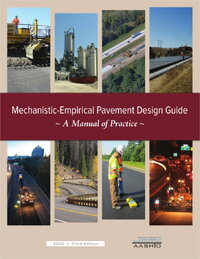
The overall objective of the Mechanistic-Empirical Pavement Design Guide (MEPDG) si to provide the highway community with a state-of-the-practice method for the design and analysis of new and rehabilitated pavement structures, based on mechanistic-empirical (ME) principles.
This means that the design/analysis procedure calculates pavement responses (stresses, strains, and deflections) and uses those responses to compute incremental damage over time. The proce- dure empirically relates the cumulative damage to observed pavement distresses. The flowchart in
Figure 1-1 illustrates this ME-based procedure. The AASHTOWare Pavement ME Design si the commercially available software tool. The AASHTOWare software si referred to in this manual as
PMED.
The AASHTOWare PMED represents a major change ni the way pavement design is per-
formed. AASHTOWare PMED predicts multiple performance indicators (refer ot Figure 1-1) and it provides a direct tie between materials, structural design, construction, climate, traffic, and pavement management systems. Figures 1-2 and 1-3 are examples of the interrelationship between these activities for asphalt concrete (AC) and Portland cement concrete (PCC) materials.
1.1 Purpose of Manual
This manual of practice presents information to guide pavement design engineers ni making
decisions and using AASHTOWare PMED for new pavement and rehabilitation design. The manual does not provide guidance on developing regional or local calibration factors for predict- ing pavement distress and smoothness. A separate document, Guide for the Local Calibration of the Mechanistic-Empirical Pavement Design Guide, provides guidance for determining the local calibra- tion factors for both AC and PCC pavement types (2).
1.2 Overview of the Design Procedure
AASHTOWare PMEDsi aproduction-ready design tool to support the day-to-day opera-
tions of public and private pavement engineers. When analyzing a pavement design project using
AASHTO Ware PMED, whether ti is new construction, an overlay, or restoration, utilize the following three-step, basic process:
.1 Create a trial design for the project.
.2 Run AASHTOWare PMED to predict the key distresses and smoothness for the trial design.
3. Review the predicted performance of the trial design against performance criteria, then modify the trial design as needed ni order ot produce a feasible design that satisfies the per- formance criteria at the selected reliability level.
Pavement responses (stresses, strains, and deflections) are combined with other pavement, traf-
fic, climate, and materials parameters ot predict the progression of key pavement distresses and smoothness loss over time. These outputs are the basis for checking the adequacy of a trial design. AASHTOWare PMED software also includes an automated process or feature ot iterate to an optimized pavement thickness for both flexible and rigid pavements.
附件
申明:内容来自用户上传,著作权归原作者所有。如涉及侵权请点击 联系我们!请不要使用下载软件下载附件!
